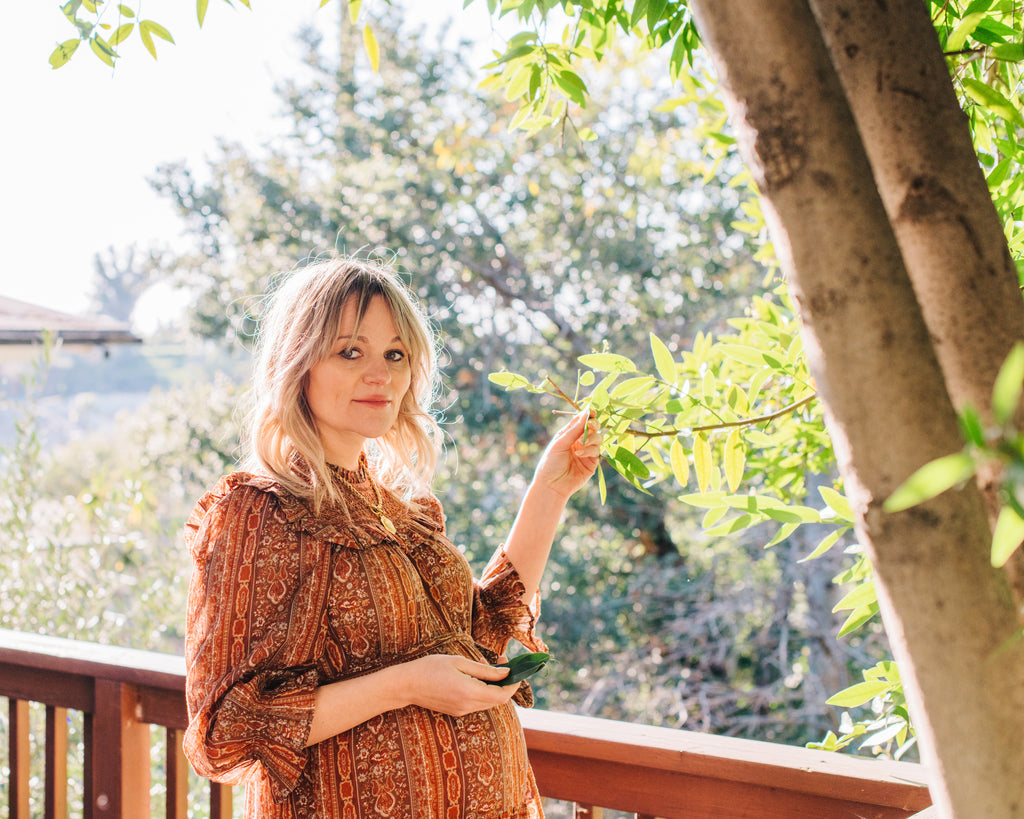Meet Master Distiller Morgan McLachlan
Morgan McLachlan grew up on the side of a mountain in Vancouver, a place so beautiful that when she visited Yosemite for the first time years ago she thought to herself, “Oh, this is just like where I grew up.” She spent most of her days under her grandparents’ watch, playing and hiking in the forest, forging what would become a lifelong relationship with plants.
It’s a childhood straight from the storybooks, and one that makes perfect sense once you know where Morgan is now: distilling spirits from botanicals growing in her Echo Park backyard here in Los Angeles. The most striking of the plants growing in her yard? The California Bay Leaf, a plant more commonly found in Northern California that somehow made its way down the coast, into Morgan’s backyard, and eventually into a bottle of AMASS Dry Gin.

Before she got her start as a distiller, Morgan followed in her father’s footsteps working in the film and television industry as a camera operator. At just 17-years-old, Morgan was the youngest person at the time working in IATSE, the International Alliance of Theatrical Stage Employees, and one of the only women. “It’s always interesting talking about gender issues if you just get into it by the numbers,” she says. “In IATSE, when I was in the union, it was five percent women.”
When she left the movie biz a decade later to pursue a career in distilling, she found herself yet again in the minority, although this time on her own terms. In 2012, Morgan co-founded The Spirit Guild, a DTLA-based distillery that specializes in making a variety of spirits from California’s diverse flora. Since founding the distillery, Morgan has helped build seven beverage brands, establishing herself as one of the leading independent distillers and, once again, one of the only women.
On why more women aren’t distillers, Morgan theorizes that most women are probably too intelligent for the job. “You’re basically a janitor,” she explains, citing the hours of cleaning and back-breaking labor as one of the reasons the industry has remained so male-dominated.
Morgan, though, is an exception to her own theory, proving that women–even and perhaps especially intelligent women–have a place in distilling. Growing up in British Columbia, Morgan knew what every plant was–which ones were poisonous, which were edible, the conditions they grew best in. So when she moved to Los Angeles over a decade ago, she sought to learn as much as she could about Southern California flora, striving to become a resident expert on the region’s lush terroir.

Morgan’s partner at the time came from an old California ranching family dating back to the 1860s, and Morgan’s knowledge of the area’s agriculture blossomed from that tie. She started experimenting with various botanicals, including citrus, something she thought couldn’t be distilled because she had never seen it done before. She went on to distill the first gin and vodka from clementines, an innovation that came from the simple question: “What would a spirit distilled in Southern California be made from?”
Unlike other distillers that prioritize experimentation above all else, Morgan knows that innovation can only follow knowledge. Distilling, much like filmmaking, relies heavily on craft, a now overused descriptor in the alcohol world that nonetheless remains the most precise, as it encompasses both technical skill and artistry. Morgan elucidates on the matter,
“You can be a really good technical distiller where the spirits you’re making are missing a certain je ne sais quoi. And then you can be a very artistic distiller, but if you don’t know the techniques or the traditions… you can make a very sloppy product… It’s sort of like art. You learn how to draw and then from there, once you know the aesthetic rules, if you break the rules you’re breaking them intentionally.”
Morgan certainly knows how to break the rules–she’s been doing it since she first started working in movies at 17. But she also understands that distilling tradition is rooted in historical context. Take bourbon, for example. Back in 1938, the Coopers Union Lobby prohibited the reusing of barrels in the production of bourbon in an effort to create jobs and spur the lagging timber industry. Now, nearly a century after the law was first put in place, we’ve become accustomed to the taste of New American, charred oak barrel bourbon. To discard the rules surrounding the production of bourbon would be to disrupt the unique, now-expected flavor of the liquor.
Trace back to the origins of most modern spirits and you’ll find a similar trajectory. What we eat and drink are reflective of the times before us, but also the times we live in now. And in order to be a thoughtful distiller, it’s important to understand the symbiotic relationship between what we make and who we are, not as individuals but as a collective.

Morgan is deeply concerned with this relationship, as is evidenced by her near encyclopedic knowledge on the history of distilling. And luckily for her, the times we live in now are a beautiful place to be on the spirits front. We’ve entered into an era of thoughtful consumption, with consumers caring deeply about what they’re putting into their bodies. The decentralization of distilling away from large industrial practices has freed makers from rigid spirits categories and allowed for unprecedented creativity and innovation. Our drinking traditions are evolving with our culture and taking us to places no one has thought to go before. The lines between non-alcoholic, low-alc, and traditional spirits are being blurred, giving consumers of all kinds an opportunity to connect.
That ability to connect over food and drink is what entices Morgan most. She tells me, “My family is Scottish, so we’re lucky if we get black pepper on our roast beef, maybe some horseradish [laughs]. If you look at the history of the spice trade, spices and botanicals were really the first thing people knew of other cultures. I think in general, food and beverage is a calling card of culture and is something everyone can appreciate and connect over.”
AMASS–a word that simply means “to gather”–celebrates the power drink has to bring people of all walks of life together. Here in Los Angeles, a multicultural city with a recently booming food and beverage scene, this rings especially true. So much of AMASS Dry Gin, AMASS’s premiere product and Morgan’s personal brainchild, is inspired by the natural terroir and diverse cultural landscape of LA. The city is felt in the spirit’s indigineous botanicals like California Bay and Cascara Sagrada, as well as in the worldy, vibrant flavors of hibiscus and cardamom. It’s not difficult to see the influence of place–it’s also not difficult to see the influence of Morgan.
Morgan never thought she’d become a distiller, nor did she ever think she’d live in Los Angeles. She tells me that on one trip to LA in her 20s, she met with a corporate psychic at 21st Century Fox, where her step-mother worked at the time. It was the early 2000s, and Morgan had big plans to move to Berlin and play in an art-rock band (on the keyboard, naturally), to which the psychic told her, “Oh honey, you’re not moving to Berlin. You’re moving to Los Angeles.” Morgan quickly disregarded the prediction: “I thought, well that’s funny, because I hate Los Angeles.” Within a few years, she was living here, sleeping on a friend’s couch, and attending parties in the Hills. It’s a classic story of “little did she know…”, but I’d argue that it’s more than that–it’s a story of Morgan and her ongoing capacity to change, like a snake in the habit of shedding skins.
Since co-founding AMASS with CEO Mark Thomas Lynn in 2018, Morgan’s role has shifted several times over. Now AMASS’s Chief Product Officer and Master Distiller, Morgan is still in the business of distilling and developing spirits, but she now oversees larger business operations as well. It’s not an entirely new realm for her to inhabit–she learned the ins and outs of how to run a business when she first founded the Spirit Guild nearly a decade ago. Outside of the office, Morgan’s life is similarly in flux–she is expecting her first child this spring, to which she says,
“I don’t know what you’re supposed to do when you’re pregnant, but I’m just going to keep working.”

When I ask her about the new direction her life and career are taking, she responds earnestly, “I’m just really excited to do everything all the time.” And that’s the truth of it. It’s not that Morgan is striving to be the best–she knows better than to strive for such empty aspirations. Rather, it’s that she wants to be the most thoughtful distiller she can be.
Distilling, at its core, is about taking simple ingredients–herbs, spices, fruit–and transforming them into a conduit for the senses. And if there’s anyone well-suited for that job, it’s Morgan. She’s read all the books. She’s learned the hard lessons. And perhaps most importantly, she delights in creating quotidian pleasures through drink. It’s a passion that does not seem to be fading, even as AMASS continues to evolve. Morgan is currently in the process of developing an aperitivo, the brand’s first foray into the low-alc space. More products–including, eventually, a non-alcoholic one, as well as a line of botanic hand washes and lotions–are set to follow. Such tremendous change could overwhelm some, but Morgan remains nonplussed. In fact, it seems that this ongoing change is what excites her most, as in it lies the possibility to transform the way we connect.
Photos by Cara Robbins

